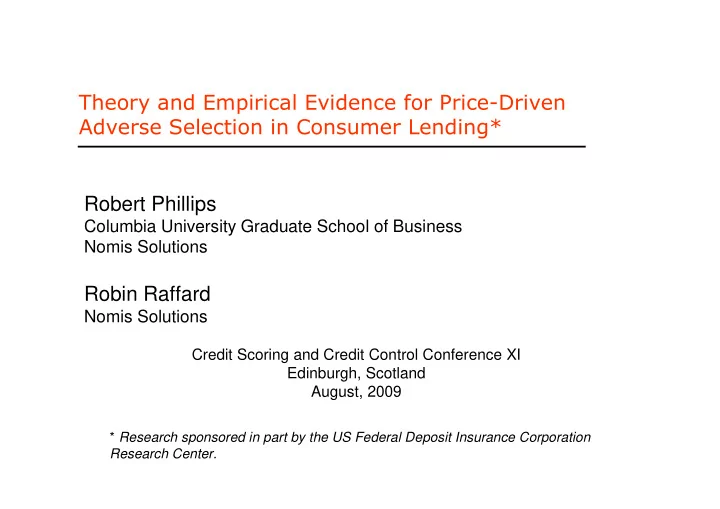

����������������������������������������������� �������������������������������������� Robert Phillips Columbia University Graduate School of Business Nomis Solutions Robin Raffard Nomis Solutions Credit Scoring and Credit Control Conference XI Edinburgh, Scotland August, 2009 * Research sponsored in part by the US Federal Deposit Insurance Corporation Research Center.
������ • Introduction: What is price-driven adverse selection and who cares? • Modeling price-driven adverse selection • Estimation of price-driven adverse selection • Empirical evidence – Example: US sub-prime auto lending – Example: Canadian personal lines of credit • Research direction and summary
�������������������������������������� • The loss behavior observed from loans funded in a population depends on the price of the product being offered: – Pricing a loan product higher will lead to higher losses. – Pricing a loan product lower will lead to lower losses. • Manifestations: – The highest-priced lender in a market segment will experience higher losses than lower-priced competitors and vice-versa, assuming similar underwriting policies. – If underwriting policy is held constant and competitors do not respond, unilaterally raising the price of a credit product will lead to higher losses from new customers while lowering the price will lead to reduced losses. • We call this phenomenon price-driven adverse selection . We are developing models of price-driven adverse selection in consumer lending markets and validating these models statistically using data from consumer lenders in the US, UK and Canada.
�������������������������������������������������� • Widely recognized as a real and important phenomenon by many lenders (especially in sub-prime and near-prime markets). • No systematic models or measures used across lenders. • Limited research: – Edelberg (2004). Using data from the US Survey of Consumer Finance, found “strong evidence” for the existence of adverse selection in mortgages and automobile loans. – Ausubel (1999), Agarwal, et. al. (n.d.). US Customers choosing an inferior credit card product (including one with a higher APR) showed higher rates of default – Karlan and Zinman (2005). Randomized experiment in South Africa showed evidence of adverse selection.
������������������������������������������! (At least) three reasons have been proposed: 1. Capacity effects : As APR’s rise, so does the difficulty of individuals to make higher payments – ( this is not considered adverse selection). 2. Financial management skills : People who accept higher APR’s tend to be those who are less sophisticated financially and thus more likely to default. 3. Private information : Those who accept higher APR’s are those who have adverse private information – e.g. high likelihood of job loss, large private debts or other liabilities, etc. The focus of our research is primarily on developing and validating models of adverse selection, not determining its underlying cause(s).
���������������������������������������������� • At any one time, consumer lending markets typically support a wide variation in pricing. For any given lender, adverse selection can be substantial. • Adverse selection influences the expected incremental profitability of a loan and thus should be incorporated in both underwriting and pricing decisions. • Price-driven adverse selection (and retention) will also influence the losses experienced from an existing portfolio of loans. • Ideally, risk scores should be “price-adjusted” to reflect the influence of price on default behavior.
��������������������������������������� ������������� "#�$ U.S. Auto Lending Rates Competition in Houston market, mid-2004 to mid-2005, FICO 700 8.00 BAC Chase Compass 7.50 FLS Services Published Buy Rate (in %) Hibernia Wells Fargo 7.00 HSBC Prime Rate 6.50 6.00 5.50 5.00 4.50 4.00 3.50 3.00 7/2/04 7/16/04 7/30/04 8/13/04 8/27/04 9/10/04 9/24/04 10/8/04 10/22/04 11/5/04 11/19/04 12/3/04 12/17/04 12/31/04 1/14/05 1/28/05 2/11/05 2/25/05 3/11/05 3/25/05 4/8/05 4/22/05 5/6/05 5/20/05 Source: Nomis Solutions analysis based on Informa Research rate sheet data
��������������������������������������� ����������������������������� ������� Britain's Best Personal Loans! %�� ������������ ������������ �����&�'��������������������������������������������������(��������)����������������������������#*+�,����&�'����������� ����������� ���������(��!��������������)������&�(��������������������������� �����������&�������������������������&����)�������(���������������� ������������������(�����+�'���������-.�������������������������/��)����'������������"(������������������01&222�����������������&� )�������������������������������������������$3 Typical TAR (£) APR (%) Lender Typical TAR (£) APR(%) Lender Direct Line 5.6 5,428.08 Moneyback Bank Secure Trust Bank** 19.5 6,509.52 5.6 5,435.28 Apply via the Fool Barclays 14.9 6,160.68 Masterloan 5.7 5,439.60 Barclaycard 14.9 6,160.68 Lombard Direct 5.8 5,443.56 Bank of Scotland 9.2 6,149.16 Northern Rock* 5.7 5,443.56 Halifax 9.2 6,149.16 Cahoot 5.8 5,447.52 Apply via the Fool ������������������������������������������� ����������������������������������� ������������������ ��!�����"#���� ����$�� Alliance & 5.9 5,458.32 Leicester Masterloan 5.9 5,459.04 (telephone) ** �����������������%������$#������$�� Source: www.motleyfool.com (ranked by total amount repayable, TAR)
���������������������������������������� If adverse selection is severe, the expected incremental profitability of a loan can actually decrease with increasing APR. This can be a particularly strong effect with sub-prime customers. Expected incremental profit from an additional loan as a function of APR £1,000 - £5,000 Loans, New Customers �������������������� Non-Internet channels: Four affinities ���������������������� ��������������� 0-22 0822 '����������� 0122 0722 ������ 0622 ������ ���������������� �9������� 0522 ��������������� 0422 ������������� ���������� 02 �8 �6 2 6 8 ������������:�";$�
�����9���������� • In highly sub-prime populations, the magnitude of adverse selection can be so great that the incremental profitability of loans is less than zero at all APR’s. • In other segments, the only APR’s that generate incrementally profitable loans are above the legal usury limit. • The optimal policy for a lender in this case is to exclude these loan/customer combinations through its underwriting policies – e.g. to ration credit (Stiglitz and Weiss [1981]). Incremental Profitability 0 APR
������ • Introduction: What is price-driven adverse selection and who cares? • Modeling price-driven adverse selection • Estimation of Price-Driven Adverse Selection • Empirical Evidence – Example: US Sub-prime auto lending – Example: Canadian Personal Lines of Credit • Research Direction and Summary
Recommend
More recommend